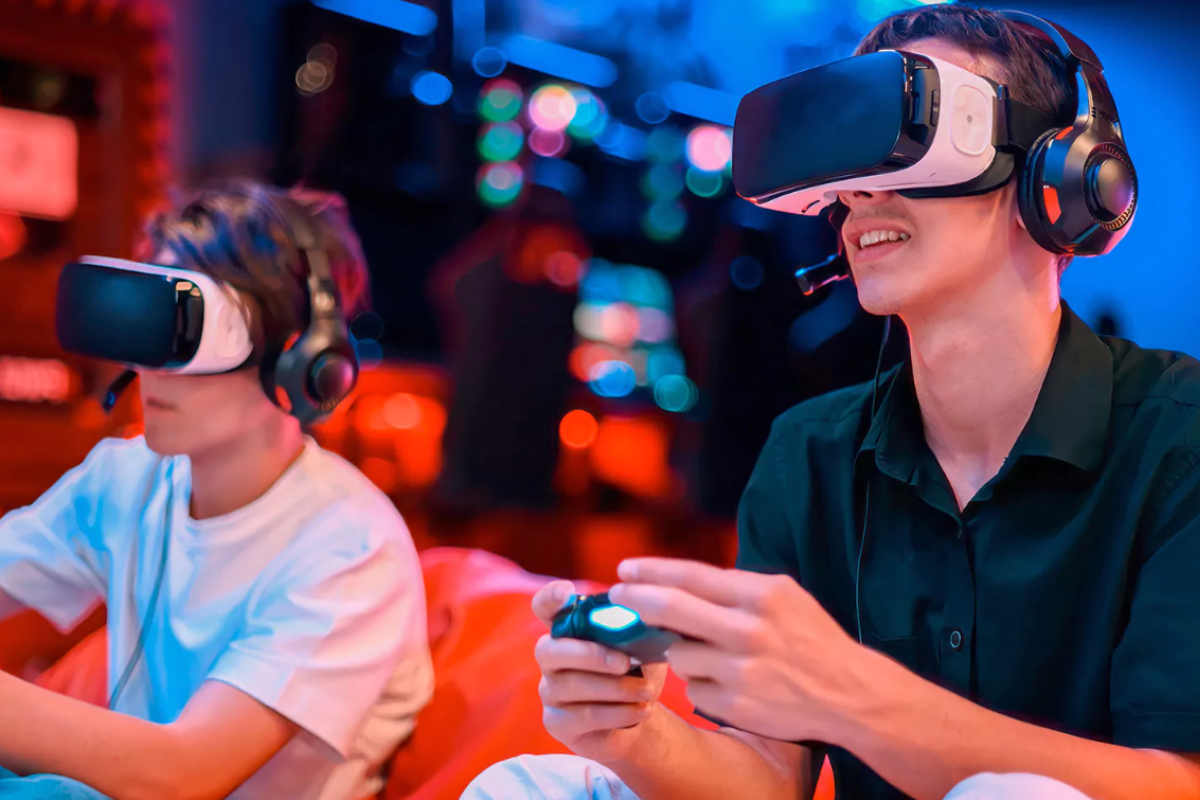Virtual reality gaming has gone from clunky goggles and short tech demos to immersive, full-body experiences that let players feel like they’re inside the game. What used to be a futuristic idea is now part of many gamers’ daily lives. Whether you’re just curious or already deep into VR worlds, understanding how this technology grew over the years helps you appreciate what’s possible today—and what’s coming next.
At its core, virtual reality gaming is about more than just fancy headsets or motion controls. It’s about how games can feel real. How they pull you into the action. And how developers continue to push boundaries with creativity and tech. From its early experimental phase to the wireless, room-scale worlds of today, the story of virtual reality gaming is one of constant adaptation and imagination.
What the Article Will Discuss
- A quick look at the earliest forms of virtual reality in gaming
- How VR tech became more accessible and user-friendly over time
- The role of modern game studios in expanding VR’s potential
- Where virtual reality gaming stands today and what’s ahead
How Virtual Reality Gaming All Began: The Early Days of VR in Gaming
Virtual reality gaming didn’t start with sleek headsets and lifelike graphics. In fact, it started with bulky equipment that barely worked and games that were more concept than fun. One of the earliest examples was the Sensorama from the 1960s—a giant machine you had to sit in to get a “virtual” experience. Later, the 1980s and ’90s saw companies trying to bring VR into arcades and homes, but most failed. The technology was either too expensive or too limited.
Nintendo’s Virtual Boy, released in 1995, was one of the first attempts to bring VR-style gaming into people’s living rooms. Unfortunately, it caused more headaches—literally—than excitement. Players complained of eye strain, and the graphics were red-and-black and far from immersive. Even though it didn’t succeed, it showed that people were interested in the idea of stepping into a game world.
Still, these early failures taught developers some important lessons. Making virtual reality gaming work meant solving problems like motion sickness, cost, and player comfort. And it would take years before all the pieces came together.
The Breakthrough: Oculus and the Return of VR Hype
Everything changed in the early 2010s. A young developer named Palmer Luckey built a prototype for a new kind of headset called the Oculus Rift. It used more modern sensors and screens, allowing smoother, more comfortable experiences. He shared his idea online, and it quickly caught attention. Even game developers got excited. The buzz around Oculus was strong enough that Facebook bought the company in 2014 for $2 billion.
That moment marked a turning point. VR was no longer a side project. It was a serious platform again.
Other companies joined in. Sony released PlayStation VR. HTC partnered with Valve to release the Vive. These devices were still pricey, but they were miles ahead of the earlier experiments. For the first time, gamers could explore 3D environments by turning their heads or walking around. Games like Beat Saber, Job Simulator, and Superhot VR proved that virtual reality gaming could be both fun and profitable.
At the same time, motion tracking improved. Hand controllers let players “grab” objects in VR. Room-scale tracking allowed people to walk short distances inside games. The dream was finally starting to come together.
Making VR More Accessible
Even though the tech was better, there were still barriers. You needed a powerful PC, cables everywhere, and a lot of space. But companies worked hard to fix these issues.
The Oculus Quest, launched in 2019, became a game-changer. It was wireless, affordable, and didn’t need a PC. Just strap it on and you’re in. Suddenly, virtual reality gaming wasn’t just for tech fans—it was for everyone. Families, casual players, and even seniors started picking up headsets.
Developers noticed. They started making simpler games that didn’t require long tutorials or motion sickness pills. Titles like Moss, The Climb, and Vader Immortal showed that you could have depth and comfort in the same package.
VR arcades also made a comeback. In malls and amusement centers, people could try VR without having to buy anything. These short demo-style games helped introduce the idea of virtual reality gaming to wider audiences.
The Role of Storytelling and Design in Virtual Reality Gaming
As hardware improved, so did the art of creating meaningful experiences. Storytelling became a huge part of VR’s success. Traditional games often rely on cutscenes, but VR puts the player right in the middle of the scene. It’s not just about watching anymore. It’s about reacting, exploring, and sometimes even talking back.
One standout example is Half-Life: Alyx, which showed how to blend deep narrative with full-body interaction. Every object you touch, every hallway you peek into—it all feels personal. Not because the game tells you it is, but because you’re physically doing it.
Developers also started to experiment with different genres. Puzzle games like Tetris Effect use music and visuals to create meditative states. Horror games became even scarier, with players truly feeling trapped. Even multiplayer VR worlds began to grow, letting people hang out, play games, or attend events together inside shared spaces.
VR and Fitness: An Unexpected Match
One surprising development in virtual reality gaming is how it has turned into a fitness tool. Instead of lifting weights or running in place, players burn calories by ducking, punching, or dancing in rhythm-based games.
Apps like FitXR, BoxVR, and Supernatural aren’t just fun—they’re effective workouts. Some players even replaced their gym routines with VR entirely. Studies showed that an hour in a high-intensity VR game could burn as many calories as a light jog.
The mix of entertainment and exercise made VR especially appealing during times when people stayed home more often. It gave them a reason to move, play, and stay active.
Where We Are Now: Today’s Virtual Reality Gaming Landscape
Today, virtual reality gaming has found its place in the mainstream. Devices are lighter, more affordable, and offer more freedom than ever before. Wireless headsets have become standard. Visuals are sharper. And social spaces are booming.
Games like Rec Room, VRChat, and Population: One let players connect with others around the globe. These aren’t just games—they’re places to hang out, compete, or just laugh with friends. The line between game and social platform is starting to blur.
Studios are also building longer and more ambitious games. While early VR titles lasted an hour or two, modern ones can stretch into 20–30 hours or more. This growth in content shows how much trust and investment the platform has earned.
At the same time, developers are more aware of player comfort. They offer different movement options—teleporting, smooth walking, or even sitting modes—to keep people from getting sick. Tutorials are shorter and cleaner. And more accessibility features make it easier for everyone to join in.
What’s Ahead for Virtual Reality Gaming?
The future of virtual reality gaming looks promising. Major companies are already working on next-generation devices with better resolution, improved eye tracking, and even full-body tracking. These upgrades could make characters in the game react to your expressions or movements more accurately.
There’s also growing interest in blending VR with other technology. Some headsets now come with mixed reality features, letting players interact with the real world while still inside a game. Think of placing a virtual pet on your actual couch—or building a bridge across your kitchen floor.
Cloud gaming could also play a role. Instead of needing a strong PC or console, the game would stream directly to your headset. That would lower costs and make access easier for everyone.
Of course, VR won’t replace traditional gaming completely. But it’s carving out its own space—one where presence matters more than pixels, and where the player’s body is part of the controller.
Why Virtual Reality Gaming Continues to Matter
Virtual reality gaming isn’t just a trend. It’s a reflection of how people want to experience digital worlds—up close, personal, and fully involved. What began as a wild idea in science labs is now shaping how stories are told and how games are played.
It gives players a new kind of freedom: the ability to not just play, but be inside the game. And as the technology keeps moving forward, that freedom will only grow.
Whether you’re swinging lightsabers, solving puzzles with your hands, or just relaxing in a virtual space, there’s something genuinely special about VR. It taps into imagination in ways other platforms can’t match. That’s why, even as trends shift and consoles evolve, virtual reality gaming holds a strong and exciting future.



